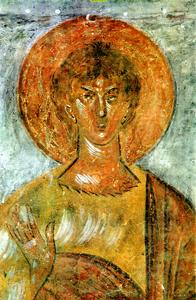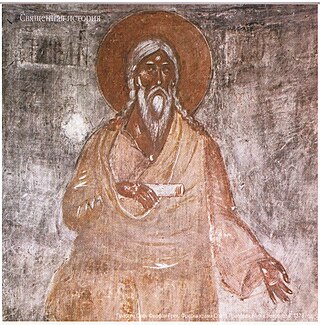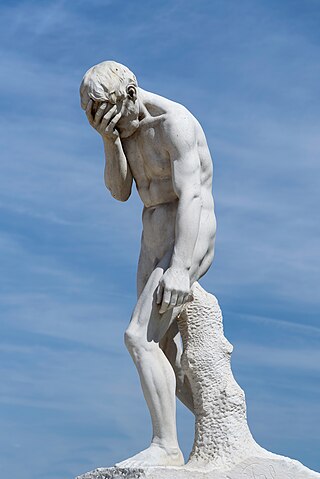Related Research Articles

Abel is a Biblical figure in the Book of Genesis within Abrahamic religions. He was a younger brother of Cain, and the second son of Adam and Eve, the first couple in Biblical history. He was a shepherd who offered his firstborn flock up to God as an offering. God accepted his offering but not his brother's. Cain then killed Abel out of jealousy.

Seth, in the Abrahamic religions, was the third son of Adam and Eve. According to the Hebrew Bible, he had two brothers: Cain and Abel. According to Genesis 4:25, Seth was born after Abel's murder by Cain, and Eve believed that God had appointed him as a replacement for Abel.

Cain is a biblical figure in the Book of Genesis within Abrahamic religions. He is the elder brother of Abel, and the firstborn son of Adam and Eve, the first couple within the Bible. He was a farmer who gave an offering of his crops to God. However, God was not pleased and favored Abel's offering over Cain's. Out of jealousy, Cain killed his brother, for which he was punished by God with the curse and mark of Cain. He had several children, starting with Enoch and including Lamech.

Enoch is a biblical figure and patriarch prior to Noah's flood, and the son of Jared and father of Methuselah. He was of the Antediluvian period in the Hebrew Bible.

The Book of Jubilees, sometimes called Lesser Genesis or Leptogenesis, is an ancient Jewish apocryphal text of 50 chapters, considered canonical by the Ethiopian Orthodox Tewahedo Church as well as Beta Israel, where it is known as the Book of Division. Jubilees is considered one of the pseudepigrapha by the Eastern Orthodox, Catholic, and Protestant churches. Apart from the Beta Israel community, the book is not considered canonical within any of the denominations of Judaism.

The Book of Enoch is an ancient Hebrew apocalyptic religious text, ascribed by tradition to the patriarch Enoch who was the father of Methuselah and the great-grandfather of Noah. The Book of Enoch contains unique material on the origins of demons and Nephilim, why some angels fell from heaven, an explanation of why the Genesis flood was morally necessary, and a prophetic exposition of the thousand-year reign of the Messiah. Three books are traditionally attributed to Enoch, including the distinct works 2 Enoch and 3 Enoch.

The Nephilim are mysterious beings or people in the Hebrew Bible who are described as being large and strong. The Hebrew word Nephilim means "giants"; some understand it to mean "the fallen ones" but this is a misunderstanding of the Hebrew. Their origins are disputed. Some, including the author of the Book of Enoch, view them as offspring of fallen angels and humans. Others view them as offspring of the descendants of Seth and Cain.
The Life of Adam and Eve, also known in its Greek version as the Apocalypse of Moses, is a Jewish apocryphal group of writings. It recounts the lives of Adam and Eve from after their expulsion from the Garden of Eden to their deaths. It provides more detail about the Fall of Man, including Eve's version of the story. Satan explains that he rebelled when God commanded him to bow down to Adam. After Adam dies, he and all his descendants are promised a resurrection.
The Books of Adam is a collective name of several apocryphal books relating to Adam and Eve.
"Generations of Adam" is a genealogical concept recorded in Genesis 5:1 in the Hebrew Bible. It is typically taken as the name of Adam's line of descent going through Seth. Another view equates the generations of Adam with material about a second line of descent starting with Cain in Genesis 4, while Genesis 5 is taken as the "generations of Noah".
The Lost Books of the Bible and the Forgotten Books of Eden (1926) is a collection of 17th-century and 18th-century English translations of some Old Testament Pseudepigrapha and New Testament Apocrypha, some of which were assembled in the 1820s, and then republished with the current title in 1926.
The Cave of Treasures, sometimes referred to simply as The Treasure, is an apocryphal and pseudoepigraphical work, that contains various narratives related to the Christian Bible. It was written in the Syriac language, approximately at the end of the 6th, or at the beginning of the 7th century. Its authorship was traditionally attributed to Ephrem of Edessa, but modern scholarly analyses have shown that the true author was some other person, who also lived in Upper Mesopotamia, but much later.

Adam is the name given in Genesis 1-5 to the first human. Adam is the first human-being aware of God, and features as such in various belief systems.

Eve is a figure in the Book of Genesis in the Hebrew Bible. According to the origin story of the Abrahamic religions, she was the first woman. Eve is known also as Adam's wife.
The Ethiopic Lamentations of Jeremiah is a pseudepigraphic text, belonging to the Old Testament canons of the Beta Israel and Ethiopian Orthodox Church. It is not considered canonical by any other Judeo-Christian groups.

Adam and Eve, according to the creation myth of the Abrahamic religions, were the first man and woman. They are central to the belief that humanity is in essence a single family, with everyone descended from a single pair of original ancestors. They also provide the basis for the doctrines of the fall of man and original sin, which are important beliefs in Christianity, although not held in Judaism or Islam.

Robert Henry Charles, was an Irish Anglican theologian, biblical scholar, professor, and translator from Northern Ireland. He is known particularly for his English translations of numerous apocryphal and pseudepigraphal Ancient Hebrew writings, including the Book of Jubilees (1895), the Apocalypse of Baruch (1896), the Ascension of Isaiah (1900), the Book of Enoch (1906), and the Testaments of the Twelve Patriarchs (1908), which have been widely used. He wrote the articles in the eleventh edition of Encyclopædia Britannica (1911) attributed to the initials "R. H. C."
Seed of the woman or offspring of the woman is a phrase from the Book of Genesis: as a result of the serpent's temptation of Eve, which resulted in the fall of man, God announces that he will put an enmity between the seed of the serpent and the seed of the woman. In Christianity, this verse is known as the protoevangelium, and is interpreted as a prophecy of the coming of Jesus. In Judaism, the "seed of the woman" is taken as a collective reference to humankind in general.
There are many Biblical figures which the Qur'an names. Some, however, go unnamed in the Qur'an, but are referenced or referred to in the hadiths, tafsirs, literature or seerah. Other figures are mentioned elsewhere in tradition and in the sunnah and sayings of Muhammad. Such figures which are not mentioned by name in the Qur'an, are included below.
In the Book of Enoch and Book of Jubilees, copies of which were kept by groups including the religious community of Qumran that produced the Dead Sea Scrolls, the Elioud are the antediluvian children of the Nephilim, and are considered a part-angel hybrid race of their own. Like the Nephilim, the Elioud are exceptional in both ability and wickedness.
References
- ↑ Charles, R.H. (2004). The Apocrypha and Pseudepigrapha of the Old Testament, Volume Two: Pseudepigrapha. Apocryphile Press. p. 127. ISBN 978-0-9747623-7-1 . Retrieved 28 June 2018.
- ↑ Jenkins, P. (2015). The Many Faces of Christ: The Thousand-Year Story of the Survival and Influence of the Lost Gospels. Basic Books. p. 144. ISBN 978-0-465-06161-7 . Retrieved 28 June 2018.
- ↑ Weinberger, E. (2016). The Ghosts of Birds. New Directions. p. 13. ISBN 978-0-8112-2619-6 . Retrieved 28 June 2018.
- ↑ Malan, S.C. (1882). The Book of Adam and Eve: Also Called the Conflict of Adam and Eve with Satan, a Book of the Early Eastern Church, Translated from the Ethiopic, with Notes from the Kufale, Talmud, Midrashim, and Other Eastern Works. Williams and Norgate. p. 6 . Retrieved 28 June 2018.
- ↑ Dillmann, A. (1853). Das christliche Adambuch des Morgenlandes. Göttingen: Dieterich. OCLC 230747084
- ↑ Malan, S. C. (1882). The Book of Adam and Eve: Also called the conflict of Adam and Eve with Satan, a book of the early Eastern Church. London, Williams and Norgate; repr. Kiesinger 2003, Gorgias Press 2010.
- ↑ "Chapter XVIII". The First Book of Adam and Eve.
- ↑ "Chapter XLIX". The First Book of Adam and Eve.
- ↑ "Chapter LIII". The First Book of Adam and Eve.
- ↑ The First Book of Adam and Eve.
- ↑ "2nd Adam and Eve, Chapter XIV".
- ↑ "2nd Adam and Eve, Chapter XVI".
- ↑ "2nd Adam and Eve, Chapter XXI".